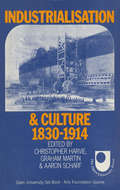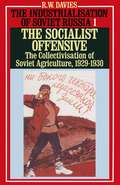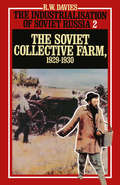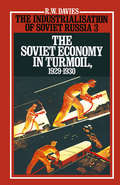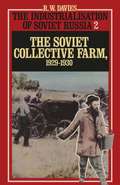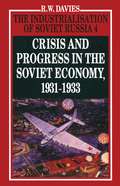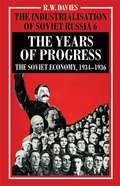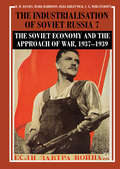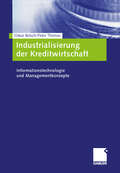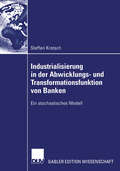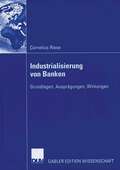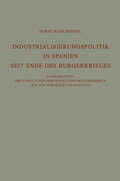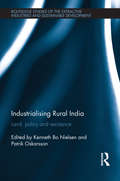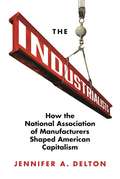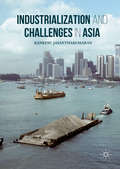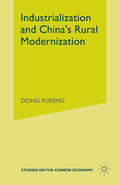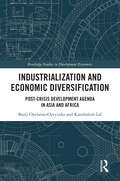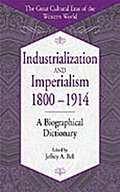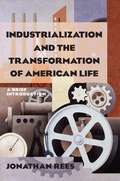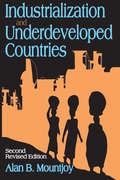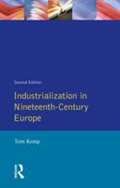- Table View
- List View
The Industrialisation of Soviet Russia 1: The Collectivisation of Soviet Agriculture, 1929-30
by R. W. DaviesBy the summer of 1929 Soviet industrialisation was well under way, but agriculture was in a profound crisis: in 1928 and 1929 grain to feed the towns was wrested from the peasants by force, and the twenty-five million individual peasant households lost the stimulus to extend or even to maintain their production. In the autumn of 1929 the Soviet Politburo, led by Stalin, launched its desperate effort to win the battle for agriculture by forcible collectivisation and by large-scale mechanisation. Simultaneously hundreds of thousands of kulaks (richer peasants) and recalcitrant peasants were expelled from their villages. This book tells the story of these events, as momentous in their impact on Russian history at the Bolshevik Revolution of October 1917, and of the temporary retreat from collectivisation in the spring of 1930 in the face of peasant resistance. The crisis in the Communist Party which resulted from this upheaval, in the months preceding the XVI party congress in June 1930, is described in detail for the first time.
The Industrialisation of Soviet Russia 2: Soviet Collective Farm, 1929-1930
by R. W. DaviesDuring the events described in The Socialist Offensive the collective farms achieved a commanding position in the Soviet countryside. They were planned as giant, fully socialist enterprises, modelled on the state-owned factories, and employing wage labour. By the summer of 1930 the collective-farm compromise had been introduced. Collective farmers were permitted to retain a personal household plot and their own animals; and a free market continued side by side with state planning. This system continued throughout the Stalin period important features of it remain in the Soviet Union today. The emergence of the collective farm in 1929-30, discussed in detail in the present volume, was thus a crucial stage in the formation of the Soviet system.
The Industrialisation of Soviet Russia 3: The Soviet Economy in Turmoil 1929-1930
by R. W. DaviesIn 1929-30, the 'spinal year' of the first five-year plan, a vast investment programme began the transformation of the Soviet Union from a peasant country into a great industrial power. This book, the third part of The Industrialisation of Soviet Russia, re-examines the breakdown of the mixed economy. In those days of heroism and enthusiasm, hunger and repression, crucial Soviet economic and political institutions were established, and are only now being effectively challenged by Gorbachev's revolution. While complementing the previous two volumes of this author's work, the book is designed to be read independently. It sheds new light on a dramatic moment in Soviet history and in the formation of the Soviet system.
The Industrialisation Of Soviet Russia: Volume 2: The Soviet Collective Farm, 1929-1930
by R W DaviesDuring the events described in The Socialist Offensive the collective farms achieved a commanding position in the Soviet countryside. The emergence of the collective farm in 1929-30, discussed in the present volume, was a crucial stage in the formation of the Soviet system.
The Industrialisation of Soviet Russia Volume 4: Crisis and Progress in the Soviet Economy, 1931-1933
by R. W. DaviesThe profound economic crisis of 1931-33 undermined the process of industrialisation and the stability of the regime. In spite of feverish efforts to achieve the over ambitious first five-year plan, the great industrial projects lagged far behind schedule. These were years of inflation, economic disorder and of terrible famine in 1933. In response to the crisis, policies and systems changed significantly. Greater realism prevailed: more moderate plans, reduced investment, strict monetary controls, and more emphasis on economic incentives and the role of the market. The reforms failed to prevent the terrible famine of 1933, in which millions of peasants died. But the last months of 1933 saw the first signs of an industrial boom, the outcome of the huge investments of previous years. Using the previously secret archives of the Politburo and the Council of People's Commissars, the author shows how during these formative years the economic system acquired the shape which it retained until the collapse of the Soviet Union in 1991.
The Industrialisation of Soviet Russia Volume 6: The Soviet Economy, 1934-1936
by R. DaviesBased on extensive research in formerly secret archives, this volume examines the progress of Soviet industrialisation against the background of the rising threat of aggression from Germany, Japan and Italy, and the consolidation of Stalin's power.
The Industrialisation of Soviet Russia Volume 7: The Soviet Economy and the Approach of War, 1937–1939
by Mark Harrison R. W. Davies Stephen G. Wheatcroft Oleg KhlevniukThis book concludes The Industrialisation of Soviet Russia, an authoritative account of the Soviet Union’s industrial transformation between 1929 and 1939. The volume before this one covered the ‘good years’ (in economic terms) of 1934 to 1936. The present volume has a darker tone: beginning from the Great Terror, it ends with the Hitler-Stalin pact and the outbreak of World War II in Europe. During that time, Soviet society was repeatedly mobilised against internal and external enemies, and the economy provided one of the main arenas for the struggle. This was expressed in waves of repression, intensive rearmament, the increased regimentation of the workforce and the widespread use of forced labour.
Industrialisierung der Kreditwirtschaft: Informationstechnologie und Managementkonzepte
by Oskar Betsch Peter SchlotenKosten- und Wettbewerbsdruck kennzeichnen den deutschen Bankensektor und üben einen nie zuvor dagewesenen Reformzwang aus. Ähnlich wie die Automobilindustrie zu Beginn der neunziger Jahre erkennen auch die Banken die Notwendigkeit, sich auf ihre Kernkompetenzen und den optimalen Ressourceneinsatz zu konzentrieren. Die Fortschritte in der IT haben die derzeitige Umbruchsituation eingeleitet und beschleunigt. Gleichzeitig kommt der IT aber auch eine Schlüsselrolle bei der Bewältigung des Strukturwandels zu. Das Buch schildert die aktuelle Situation der Banken und zeigt anhand "industrieller" Management- und Reformkonzepte Lösungswege auf.
Industrialisierung in der Abwicklungs- und Transformationsfunktion von Banken: Ein stochastisches Modell
by Steffen KrotschSteffen Krotsch entwickelt ein stochastisches Modell zur Bankindustrialisierung, das moderne Verfahren zur Gesamtbanksteuerung bzw. Risiko-Ertrags-Optimierung umfasst. Es zeigt sich, dass stärker industrialisierte Banken in stabilen Märkten risikoaverser agieren, aber nicht alle Industrialisierungstendenzen als positiv einzuschätzen sind.
Industrialisierung von Banken: Grundlagen, Ausprägungen, Wirkungen
by Cornelius RieseCornelius Riese identifiziert und analysiert entlang der Wertschöpfungskette wesentliche Industrialisierungstendenzen von Banken und präsentiert ein Modell, das das Verhalten gering und stark industrialisierter Banken simuliert und damit Aufschluss über die Vorteilhaftigkeit der Industrialisierungstendenzen aus Sicht der verschiedenen Stakeholder gibt.
Industrialisierungspolitik in Spanien Seit Ende des Bürgerkrieges: Auswirkungen des staatlichen Wirtschaftsinterventionismus auf des Wirtschaftswachstum (Die industrielle Entwicklung #7)
by Horst Hans HergelDie wirtschaftspolitischen Reformen vom Sommer 1959 waren Anlaß dafür, daß nach langen Jahren, in denen nur ein kleiner Kreis die wirtschafHichen Vorgänge in Spanien verfolgt hatte, nunmehr das Interesse an der spani schen Wirtschaftspolitik wieder breiten Raum eingenommen hat. Gerade in dieser Phase des unvermittelt stark zunehmenden Interesses wird, nachdem sich eine Reihe unerwarteter Erscheinungen seit jenen Reformen vor mehr als zwei Jahren eingestellt hat, das Fehlen einer hinreichenden Erklärung für diese neuesten, im Zuge der wirtschaftlichen Integration Westeuropas auf breites Interesse stoßenden wirtschaftlichen Vorgänge empfunden. Wie nicht unschwer zu vermuten, liegt der Schlüssel für das Verständnis der neuesten wirtschaftlichen Entwicklung in Spanien in der während der un mittelbar vorausgegangenen zwei Jahrzehnte betriebenen Wirtschaftspolitik, die gegen Ende des spanischen Bürgerkrieges (1936 bis 1939) einsetzt und zumindest bis zu jenen Reformen vom Sommer 1959 reicht. Unmittelbar auf diesem Zeitraum zwischen 1939 und 1959 liegt deshalb auch das Schwergewicht der vorliegenden Untersuchung (Teil A und Teil C). Es beansprucht zwischen einer historischen Untermauerung (Teil B) und einer Darlegung der nachfolgenden Erscheinungen (Teil D) den beherrschen den Teil der Arbeit. Andererseits läßt gerade dieses Eingelagertsein zwischen den vorausgehenden historischen Erscheinungen und der Darstellung der anschließenden jüngsten wirtschaftlichen Entwicklung die Erwartung zu, daß diese für die spanische Industrialisierungspolitik - wie noch zu zeigen ist - ausschlaggebende Periode zwischen 1939 und 1959 in dieser Arbeit bereits eine weitgehend abschließende Beurteilung finden konnte.
Industrialising Rural India: Land, policy and resistance (Routledge Studies of the Extractive Industries and Sustainable Development)
by Kenneth Bo Nielsen Patrik OskarssonRapid industrialisation is promoted by many as the most feasible way of rejuvenating the Indian economy, and as a way of generating employment on a large scale. At the same time, the transfer of land from rural communities and indigenous groups for industrial parks, mining, or Special Economic Zones has emerged as perhaps the most explosive issue in India over the past decade. Industrialising Rural India sheds light on crucial political and social dynamics that unfold today as India seeks to accelerate industrial growth. The volume examines key aspects that are implicated in current processes of industrialisation in rural India, including the evolution of industrial and related policies; the contested role of land transfers, dispossession, and the destruction of the natural resource base more generally; and the popular resistance against industrial projects, extractive industries and Special Economic Zones. Combining the work of scholars long established in their respective fields with the refreshing approach of younger scholars, Industrialising Rural India seeks to chart new ways in the study of contemporary industrialisation and its associated challenges in India. This cutting-edge interdisciplinary work will be of interest to scholars working on industrial development and land questions in India and South Asia alongside those with an interest in sociology , political science and development research.
Industrialising Rural India: Land, policy and resistance (Routledge Studies of the Extractive Industries and Sustainable Development)
by Kenneth Bo Nielsen Patrik OskarssonRapid industrialisation is promoted by many as the most feasible way of rejuvenating the Indian economy, and as a way of generating employment on a large scale. At the same time, the transfer of land from rural communities and indigenous groups for industrial parks, mining, or Special Economic Zones has emerged as perhaps the most explosive issue in India over the past decade. Industrialising Rural India sheds light on crucial political and social dynamics that unfold today as India seeks to accelerate industrial growth. The volume examines key aspects that are implicated in current processes of industrialisation in rural India, including the evolution of industrial and related policies; the contested role of land transfers, dispossession, and the destruction of the natural resource base more generally; and the popular resistance against industrial projects, extractive industries and Special Economic Zones. Combining the work of scholars long established in their respective fields with the refreshing approach of younger scholars, Industrialising Rural India seeks to chart new ways in the study of contemporary industrialisation and its associated challenges in India. This cutting-edge interdisciplinary work will be of interest to scholars working on industrial development and land questions in India and South Asia alongside those with an interest in sociology , political science and development research.
The Industrialists: How the National Association of Manufacturers Shaped American Capitalism (Politics and Society in Modern America #138)
by Jennifer A. DeltonThe first complete history of US industry's most influential and controversial lobbyistFounded in 1895, the National Association of Manufacturers—NAM—helped make manufacturing the basis of the US economy and a major source of jobs in the twentieth century. The Industrialists traces the history of the advocacy group from its origins to today, examining its role in shaping modern capitalism, while also highlighting the many tensions and contradictions within the organization that sometimes hampered its mission.In this compelling book, Jennifer Delton argues that NAM—an organization best known for fighting unions, promoting "free enterprise," and defending corporate interests—was also surprisingly progressive. She shows how it encouraged companies to adopt innovations such as safety standards, workers' comp, and affirmative action, and worked with the US government and international organizations to promote the free exchange of goods and services across national borders. While NAM's modernizing and globalizing activities helped to make American industry the most profitable and productive in the world by midcentury, they also eventually led to deindustrialization, plant closings, and the decline of manufacturing jobs.Taking readers from the Progressive Era and the New Deal to the Reagan Revolution and the Trump presidency, The Industrialists is the story of a powerful organization that fought US manufacturing's political battles, created its economic infrastructure, and expanded its global markets—only to contribute to the widespread collapse of US manufacturing by the close of the twentieth century.
Industrialization and Challenges in Asia
by Kankesu JayanthakumaranThis book provides a much-needed review of Asia’s economic growth and its challenges in the context of post-war industrialization. In the early 1990s, the World Bank (1993) recognized eight high-performing Asian economies (HPAEs) (Japan, the Asian tigers, Indonesia, Malaysia and Thailand) and named them the ‘Asian economic miracle’. In the recent past, the term ‘emerging economies’ has been widely used to refer to the high-growth economies, and includes China, India, Mongolia and Vietnam. In this rush towards high growth, the adverse effects of industrialization are widespread, but were unnoticed. The major challenge is to bring together a comprehensive picture of Asia’s growth, taking into account the adverse consequences. Finally, this book examines two challenges for the future of Asia's development: the global financial crisis and urban poverty and inequality.
Industrialization and China’s Rural Modernization (Studies on the Chinese Economy)
by Dong FurengThis book analyses China's historical experience of industrialization. It adopts a critical stance towards China's development strategy and proposes an alternative approach, outlining its main features. Due to the great importance and special problems of China's rural modernization, special attention is devoted to analysis of the rural sector. Many of China's rural socio-economic problems are similar to those encountered in other developing countries. It is intended that the book will increase understanding of China's socio-economic development as well as contributing to wider debates in the theory of economic development.
Industrialization and Economic Diversification: Post-Crisis Development Agenda in Asia and Africa (Routledge Studies in Development Economics)
by Banji Oyelaran-Oyeyinka Kaushalesh LalEconomic diversification entails a shift away from a single income source toward multiple income sources from an increasing spectrum of sectors and markets. A persistent concern for some Asian and African economies is their reliance on commodity exports and how they are exposed to the risk of export volatility and income instability. The Covid-19 pandemic and previous oil crashes have demonstrated the adverse impact on such economies. This book provides a systemic analysis of sustainable economic development through economic diversification. The book analyzes diversification and development experiences from comparative perspectives of Asia and Africa. It also investigates determinants of export diversification differentiated by commodities-dependence versus manufactured products and looks at the roles of various institutions and governance of institutions in export diversification. This book will provide policy insights into how different degrees of specialisation in exports across countries have affected outcomes in terms of living standards, economic growth and employment.
Industrialization and Economic Diversification: Post-Crisis Development Agenda in Asia and Africa (Routledge Studies in Development Economics)
by Banji Oyelaran-Oyeyinka Kaushalesh LalEconomic diversification entails a shift away from a single income source toward multiple income sources from an increasing spectrum of sectors and markets. A persistent concern for some Asian and African economies is their reliance on commodity exports and how they are exposed to the risk of export volatility and income instability. The Covid-19 pandemic and previous oil crashes have demonstrated the adverse impact on such economies. This book provides a systemic analysis of sustainable economic development through economic diversification. The book analyzes diversification and development experiences from comparative perspectives of Asia and Africa. It also investigates determinants of export diversification differentiated by commodities-dependence versus manufactured products and looks at the roles of various institutions and governance of institutions in export diversification. This book will provide policy insights into how different degrees of specialisation in exports across countries have affected outcomes in terms of living standards, economic growth and employment.
Industrialization And Imperialism, 1800-1914: A Biographical Dictionary (The\great Cultural Eras Of The Western World Ser.)
by Jeffrey A. BellThis book presents an age of nationalism, imperialism, modernization, industrialism, and great cultural achievement, stretching from 1800, when Europe was awash in the wake of the French Revolution, the reign of terror, and the coming rise of Napoleon, to Archduke Franz Ferdinand's assassination in 1914. Concise biographical entries provide basic information on the great talents of the era--Beethoven, the Romantic poets, Hegel--as well as leaders in the modernization and industrialization of Western culture. Included are figures who played major roles on the imperialist and nationalist stage, those--such as Darwin and Planck--who made significant contributions to science, and those who struggled for women's rights and Abolition in the United States.
Industrialization and the Transformation of American Life: A Brief Introduction
by Jonathan ReesThis book provides a descriptive, episodic yet analytical synthesis of industrialization in America. It integrates analysis of the profound economic and social changes taking place during the period between 1877 and the start of the Great Depression. The text is supported by 30 case studies to illustrate the underlying principles of industrialization that cumulatively convey a comprehensive understanding of the era.
Industrialization and the Transformation of American Life: A Brief Introduction
by Jonathan ReesThis book provides a descriptive, episodic yet analytical synthesis of industrialization in America. It integrates analysis of the profound economic and social changes taking place during the period between 1877 and the start of the Great Depression. The text is supported by 30 case studies to illustrate the underlying principles of industrialization that cumulatively convey a comprehensive understanding of the era.
Industrialization and Underdeveloped Countries
by Alan B. MountjoyThe volume of relevant research and literature on this topic is growing but originates mainly from economists, sociologists, and political scientists; geographers have been slow to make contributions. One reason may be that geographers have been preoccupied with differentiation within the geography of production whereas this new field directs attention to the geography of consumption and a study of economies. This book aims to focus attention on the complex and inter-related problems--social, economic, political, and geographical--that come with development, placing particular emphasis on the problems which accompany attempts at industrialization. Focusing on the complex and interrelated social, economic, political, and geographic problems that attend under-development, this book presents one of the first contributions from a geographer on what has been called the most important economic problem of the modern world.Contending that industrialization is no answer for under-developed countries that are striving to maintain expanding populations and to strengthen their economy, Alan B. Mountjoy traces the distribution, causes, and problems of under-development and the difficulties with and possibilities for industrialization as an aid in solving those problems. He defines development and under-development, considers problems of industrialization (including environmental and human problems), discusses the forms industrialization takes, and analyzes the progress of industrialization in specific under-developed areas.The unique geographer's perspective and the ability of the author to select aspects of the study that most clearly reflect the problems of under-developed economies make this work a useful text and reference book for students and scholars of development, economic geography, and international relations.
Industrialization and Underdeveloped Countries
by Alan B. MountjoyThe volume of relevant research and literature on this topic is growing but originates mainly from economists, sociologists, and political scientists; geographers have been slow to make contributions. One reason may be that geographers have been preoccupied with differentiation within the geography of production whereas this new field directs attention to the geography of consumption and a study of economies. This book aims to focus attention on the complex and inter-related problems--social, economic, political, and geographical--that come with development, placing particular emphasis on the problems which accompany attempts at industrialization. Focusing on the complex and interrelated social, economic, political, and geographic problems that attend under-development, this book presents one of the first contributions from a geographer on what has been called the most important economic problem of the modern world.Contending that industrialization is no answer for under-developed countries that are striving to maintain expanding populations and to strengthen their economy, Alan B. Mountjoy traces the distribution, causes, and problems of under-development and the difficulties with and possibilities for industrialization as an aid in solving those problems. He defines development and under-development, considers problems of industrialization (including environmental and human problems), discusses the forms industrialization takes, and analyzes the progress of industrialization in specific under-developed areas.The unique geographer's perspective and the ability of the author to select aspects of the study that most clearly reflect the problems of under-developed economies make this work a useful text and reference book for students and scholars of development, economic geography, and international relations.
Industrialization in Nineteenth Century Europe
by Tom KempWritten for the layman as well as the economic historian this famous and much-used book not only presents a general synthesis of the pattern of European industrialisation; it also provides material for a comparative study by illustrating, in separate case studies, the specific characteristics of development in Britain, France, Germany, Russia and Italy.
